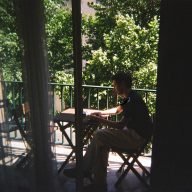Creative DNA
Spent random moments between work getting Hugo working with my VPS. As much as I like to make fun of the aesthetic choices prevalent in the tech scene right now, I have to admit I’m much more likely to use and understand tools when they are documented on GitHub and ReadTheDocs than with long, over-formatted tutorials with all kinds of gross embedded links and widgets. Wordpress is so bogged down with useless crap, I couldn’t imagine using it long term. Actually thinking about delving into Hugo theme creation myself, would like to get a base16 with spacemacs’ colors going, maybe even use custom markdown, use colors as alias for blog tags, would make sorting my writing easier, and keep me from needing to do too much metadata manipulation.
It’s funny, I am thinking about all kinds of tools and tricks I want to use to make this whole thing easier and more hands off, and I don’t really have any content yet. Guess that’s why I gravitated more towards coding in college than creative writing. My interest in both has always been in the essence of creating systems, rather than the contents of the systems. Which is even further complicated by the fact that my only recent work of fiction was very much a ”inside the mind of” story, a la Murakami…
I suppose figuring out my creative modes is part of why I’m doing this. I remember reading Twyla Tharp’s The Creative Habit in preparation for nanowrimo in 2019, and having a bit of a creative identity crisis over that exact question. In the chapter your creative DNA she talks about creative “focal length”, where you situate your own consciousness as object in relation to the subject of your work. Obviously the term applies easily to cinematographers and photographers, but to writers too. J.R.R. Tolkien wrote his epic stories from a bird’s eye view, he invented languages and mapped out intricate geography of his world before he even knew he was goin to write The Lord of the Rings, it was just part of his creative DNA. When I first read this chapter. I panicked. What is my DNA? I like big sweeping stories, with a focus on philosophical questions and sociological themes, but often the parts of stories, even the big sweeping ones, that stick with me the longest, are the close and personal moments, the sorrow or catharsis that make your whole body ache. So what was I? I felt completely paralyzed. I spent about 2 weeks of my hobby time leading up to November following writing guides. I used The Snowflake Method mapped out story beats according to The Blake Snyder Beat Sheet as defined in Save The Cat!, I even went as far back as to reassess the very foundations of Joseph Campbell’s The Hero’s Journey and tried to find that central, crystalizing gem of primal energy that I wanted to express, and where it fit into the tradition and meaning of being a storyteller.
I came up with a few different plans, and showed them to friends and family. Nothing really seemed to stick out, and I didn’t feel particularly attached to any of them. But then something crazy happened. It was November 1st, and I just started writing. I had just been reading some Murakami—A Wild Sheep Chase to be exact— and I felt a little guilty that maybe I was just tracing over the outlines of stories that were still fresh in my mind. But it was me writing, and I just let it continue. I didn’t think about chapters, I didn’t think about story beats, I made up characters as the story needed them. The only thing I really held myself too was my pace of words per day necessary to meet the 40,000 mark. And it worked. 30 days later I had a short novel. It needed editing, badly, but it was there. It reminded me of the buddhist idea of learning rules of a system, so that you can forget them. The spirit of all the lessons I had learned were there, and story held the tempo of a journey, but I didn’t let myself actively think about them, at least not while writing. I would finish my writing for the day, and maybe look over a few things, and work out while thinking about what was needed next, but never during my writing time was I wondering where the story would go.
I don’t think I have the full answers yet, about my creative DNA, but I do know that the only way to know my DNA is to let it self replicate. It has to take shape as a body of work before I can observe it properly.
